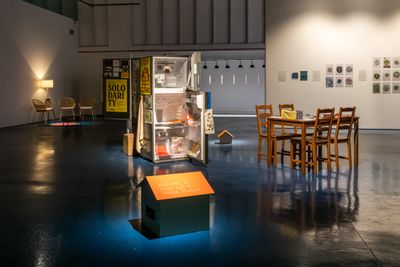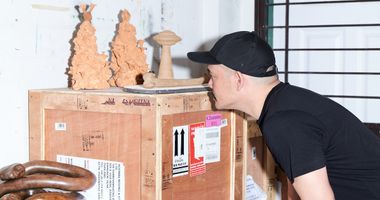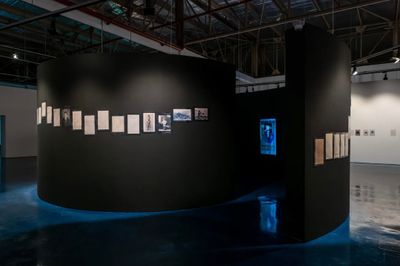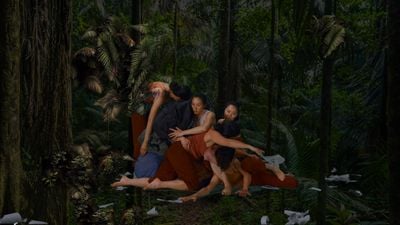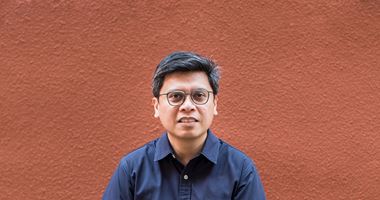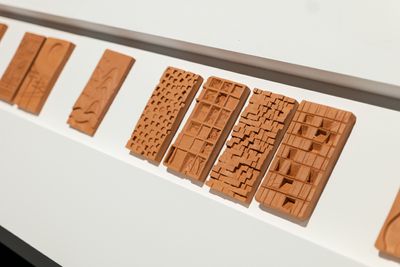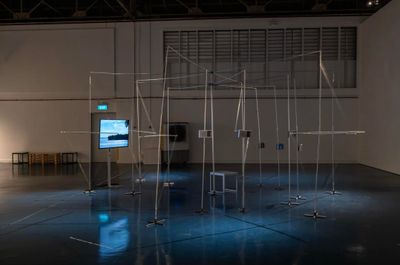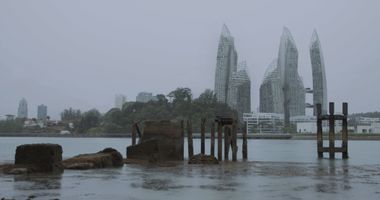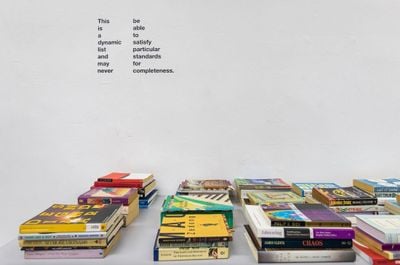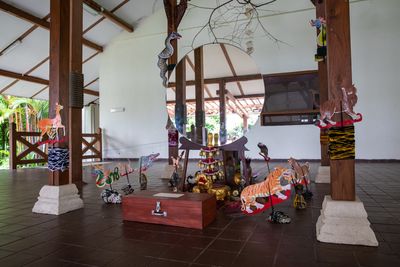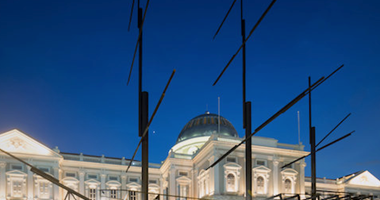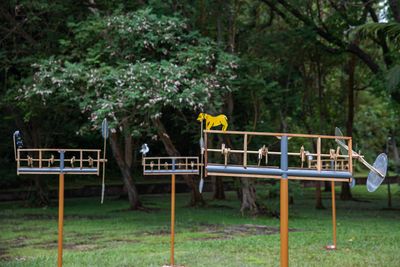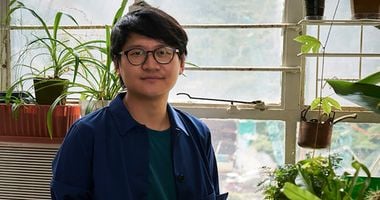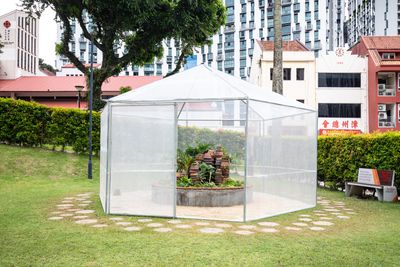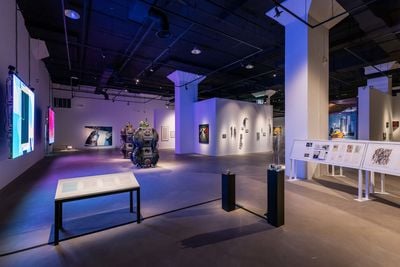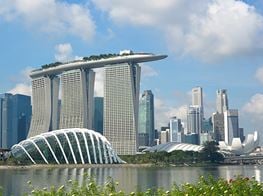Will Singapore Biennale Live Up to Its Name?

Haegue Yang, The Hybrid Intermediates – Flourishing Electrophorus Duo (The Sonic Intermediate – Hairy Carbonous Dweller and The Randing Intermediate – Furless Uncolored Dweller) (2022). Exhibition view: Natasha, Singapore Biennale 2022 (16 October 2022–19 March 2023). Courtesy Singapore Art Museum.
In the months leading up to its opening, Natasha, the 7th Singapore Biennale (16 October 2022–19 March 2023), has consistently attempted to build an aura of intrigue premised upon two sequential actions delivered in short, cryptic missives to the press.
First, the Biennale will turn away from the 'conventional preoccupation with the visual' towards 'interiority ... other senses and sensibilities'. Second, that it will, for the first time, be named instead of titled.
In lieu of aphorisms, Natasha's naming, devised by co-curators June Yap, Nida Ghouse, Ala Younis, and Binna Choi, endeavours to pivot away from the pensive—and occasionally bleak—thematics of fellow mega-exhibitions to favour an embodied notion of the artistic experience that may intertwine art with life, ostensibly for all.
Featuring 62 artists and collectives whose works are scattered around Singapore's commercial districts and southern islands, the core of Natasha's expansive, non-indicative thesis is mostly spread across three floors of Tanjong Pagar Distripark. The port-side warehouse is where Singapore Art Museum, which organises the biennial, is based while renovations are underway at its original campus.
Conceptually ambitious at the expense of discursive framing and accessibility, Natasha buckles under the weight of trying to balance two polar options. On the one hand, siting the biennial as an organic whole that arbitrates a vaguely critical, but ultimately unthreatening discourse of positive social relations. On the other, positing the exhibition as an empty signifier for a theoretically informed public to decode and extrapolate to divine their own nuanced understandings.
The opacity of this curatorial treatment is occasionally troubling. However, it is also within the gaps of this vacillating tension that the artworks do their best to highlight both the ambivalence of artistic production and the affective registers they occupy.
For example, Kiraṇ Kumār's Six uneasy fragments (exactly) about the natural and spiritual (2022) is a piece of speculative historical fiction dwelling on the early years of computer science pioneer Alan Turing and his ties to colonial India and Indonesia.
Around the outer surface of a snail-shaped wall, a series of digital prints unfurl, before opening up to reveal a small room with a six-channel video that continues to visualise Turing's potential encounter with premodern tāntrik practices that might have shaped his later theorisations.
Part philosophical musing on the centrality of non-Western spiritualities in the construction of Western technocracy, part tender imagining of a scholar's burgeoning intellectual developments, Kumār's malleable historicisation illuminates the sublime potential of a polyphonic episteme that challenges the binary construction of a non/Western worldview by centring the tentative cosmopolitanism of an important public thinker.
Blurring the lines between documentation and reflection, Kumār deftly negotiates different forms of textuality to present a layered articulation of a decolonial intellectual future. These plural possibilities of historical mediation are shared by Raed Ibrahim's Scripted Tablets (2022), which was developed over the course of a reciprocal residency programme between Natasha and the Jordan-based arts centre Darat al Funun.
Forty-five engraved terracotta clay tablets each depict a unique scene or texture. The near-infinite permutations of available arrangements demonstrate the ways readings of history can be arbitrated over time, while the use of clay indicates the vulnerability of historical accounts to the elements and their ability to be reformed.
Working with a symbolic lexicon ranging from the obviously representational (one tablet features a loose circle of electrical plugs, and another, sun and wind on skyscrapers), to the abstract, Ibrahim's wry ordering also recalls the rhythms and structures of a new grammar and its ability to propose a new sense of the world.
Sense-making as a tangible methodology also lies at the heart of Moad Musbahi's 'air cut into song' (2022), a collaborative project with design engineer and artist Flora Weil, audiographer and sound artist Sukanta Majumdar, and others. Dispersed across Tanjong Pagar Distripark and Lazarus Island, four installations function as one meteorological relay system.
The work quite elegantly articulates the quantifying functions of weather reporting as a metaphor for the techno-logic of predictability and control—itself spawned from a long lineage of environmental engineering operating under coloniality.
Entering the main latticed installation on the mainland, the sleek, hard tactility of the metal pole and radios recalls the aesthetics of field equipment and telemetric apparatuses, seeking perhaps to illuminate the flawed objectivity embedded in the Western pursuits of a specific empirical imaginary over the environment.
Amidst these works, a niggling question tugs at one's thoughts: where is Natasha?
While offshore, a sound installation recounting past weather reports highlights the fallacies of imposed sense-making upon non-human agents, whose variable natures are impossible to predict with fidelity.
Located on the nearby St. John's Island, Zarina Muhammad's Moving Earth, Crossing Water, Eating Soil (2022) similarly probes into non-human ways of knowing. The work continues her ongoing exploration of erased Indigenous cosmologies and epistemes centred around Singapore and the larger Nusantara region in Indonesia.
Occupying the centre of a large gazebo and a small field behind, the work is split between a larger shrine-like installation with paper effigies of animals signifying cardinal and ordinal directions, and a series of hand and wind-cranked musical instruments that warble with a warm timbre.
Playful yet sensuous, Muhammad's work deploys the tropes of grounded mysticism with a finesse that hints at the concealment of native narratives. It gestures at capital violence within a framework of operation foisted upon newly made territories to expunge and displace in preparation for neoliberal development.
Returning to the mainland, the affective tenor of guilt over imbalanced power relations between humans and their non-human charges—in this instance, impulse-bought houseplants—takes centre stage in Trevor Yeung's The Pavilion of Regret (2022), which provides a further touch of levity in an exhibition discourse that is occasionally bloated on the global survey of socio-political struggles and survivals.
Housed in a makeshift greenhouse, the work invites the public to drop off unwanted houseplants, or alternately, pick up and adopt new vegetal kin as a way to reflect on the object-relation between botanical agents and humans, and its alterity from animal-human bonds.
Speaking to how non-human agency could be defined against conventional imaginaries of animality and other lifeforms, Yeung imbues the slow-motion vitalism of houseplants with an emotional charge that creates a sardonic, if sometimes problematic, anthropomorphism to invite reconsideration of what we want out of our plants, and each other.
Amidst these works, a niggling question tugs at one's thoughts: where is Natasha? From one collateral to the next, copy teeters between nondescript descriptions of Natasha's purported participation in the public sphere and the logistical naming of the larger operation, Singapore Biennale 2022.
While the curatorial team enthuses over the multiplicities of possible engagement with Natasha, most remain amorphous on practical terms. If Natasha is a journey, where and whence is the beginning? If Natasha is meant to generate a personal subjectivity with the audience, why is there no personality to it, the way Mindaugas embodied the 11th Baltic Triennial—with real, nameable interventions?
In its genderedness, its markedness, Natasha—the name, the operation, and the referent—trembles for a word it never quite articulates. One struggles to define its agency against its mission, entityhood, and discourses. Yes, as a major cultural operation, Natasha can indeed speak, but who will it speak for? What will it say? —[O]

![Maile Meyer and Drew Kahuʻāina Broderick, KĪPUKA [for "Natasha"] (2022). Exhibition view: Natasha, Singapore Biennale 2022 (16 October 2022–19 March 2023).](https://files.ocula.com/anzax/Content/Reports/2022/November/Singapore%20Biennale/Installation-view-of-Maile-Meyer-Drew-Kahuaina-Brodericks-KIPUKA-for-Natasha-2022-as-part-of-Singapore-Biennale-2022-named-Natasha-Image-courtesy-of-Singapore-Art-Museum_400_0.jpg)

